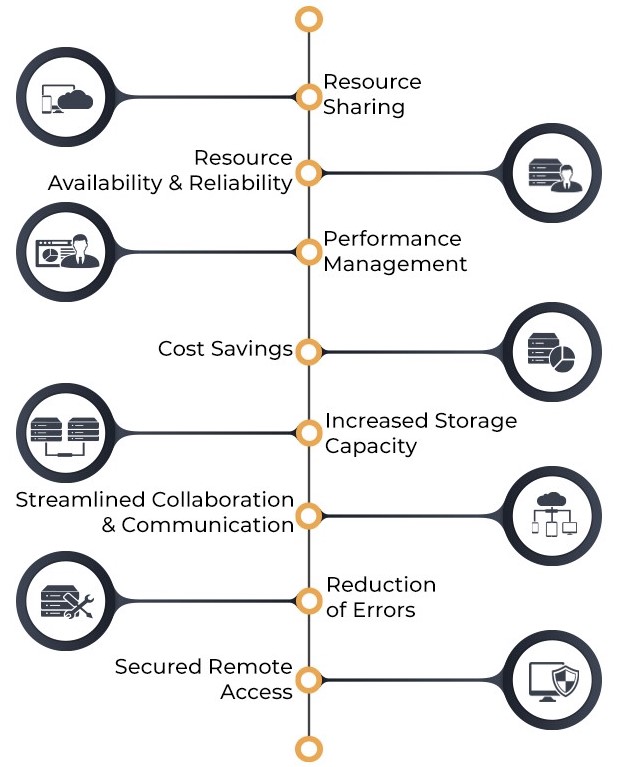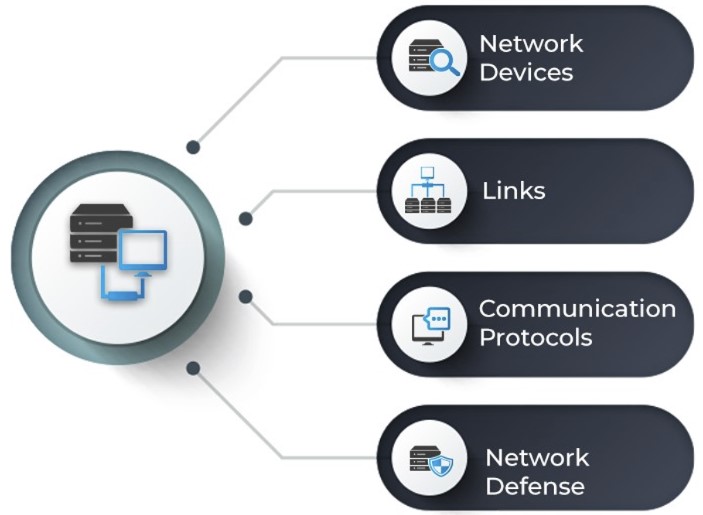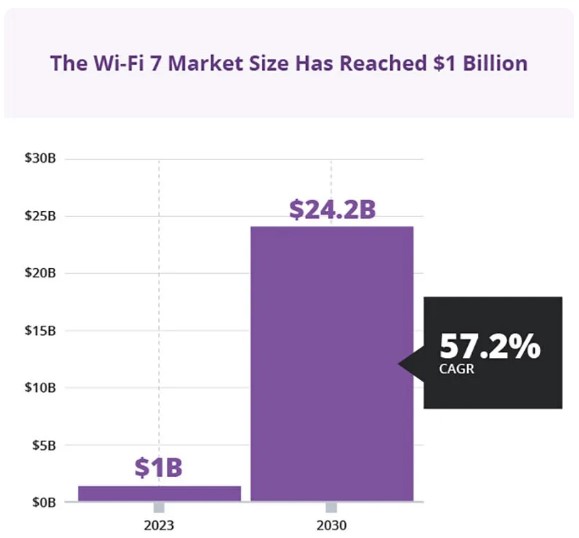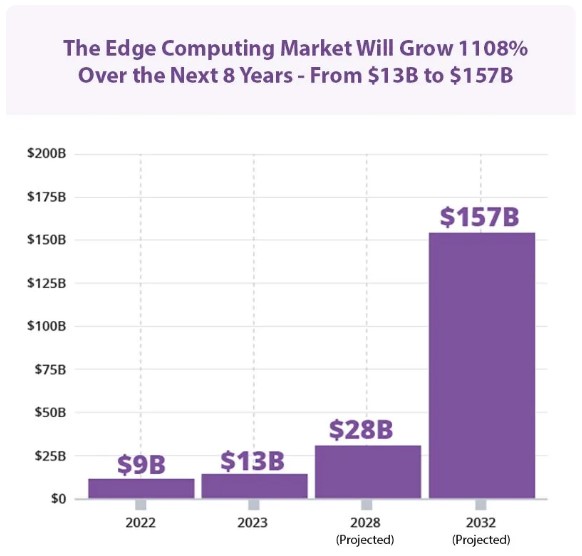Networking
The Importance of Networking
Networking is the interconnected system of devices and software that facilitates communication and data exchange in the IT world. It encompasses various technologies and protocols, including LANs, WANs, VPNs, and cloud-based solutions. Networking plays a crucial role in enabling resource sharing, collaboration, and access to information across different platforms and locations. It serves as the backbone of modern digital operations, supporting businesses by allowing employees to connect to corporate systems, access the internet, and communicate internally and externally. Additionally, networking underpins critical infrastructure such as data centers and helps in deploying and managing applications and services.
Types of Enterprise Computer Network
Networking technology is evolving rapidly. In the past, computer networks had to be joined by physical cables. In contrast, nowadays, networks can be wireless spread out among different locations connecting employees across the world. With so many people working remotely or at home, it is essential to have a flexible yet secure computer network to keep your business safe and functioning optimally.
LAN: A Local Area Network (LAN) is a network that covers a small area, such as an office or a home. LANs are typically used to connect computers and other devices within a building or a campus.
WAN: A Wide Area Network (WAN) is a network that covers a large geographic area, such as a city, country, or even the entire world. WANs are used to connect LANs together and are typically used for long-distance communication.
Cloud Networks: Cloud Networks can be visualized with a Wide Area Network (WAN) as they can be hosted on public or private cloud service providers and cloud networks are available if there is a demand. Cloud Networks consist of Virtual Routers, Firewalls, etc.
These are just a few basic concepts of computer networking. Networking is a vast and complex field, and there are many more concepts and technologies involved in building and maintaining networks. Now we are going to discuss some more concepts on Computer Networking.
Best Practices for Computer Network Management

Industry Leaders in Networking
In the realm of networking, industry leaders such as Dell, Juniper, Cisco, Netgear, HPE, Nvidia, and TP-Link stand out for their pivotal roles in shaping interconnected systems. These companies offer a wide range of networking solutions, from hardware infrastructure to software-defined networking and cloud-based services. Leveraging cutting-edge technologies and robust protocols, they enable seamless communication and data exchange across organizations of all sizes. Whether it's enterprise-level data centers or small office networks, these companies provide scalable and reliable networking solutions tailored to meet diverse customer needs.
Optimize your Network Infrastructure and Drive Success for Your Business
Networking presents numerous benefits, including streamlined operations, heightened productivity, cost savings, and fortified data security. To harness these advantages and customize networking solutions to suit your specific business requirements, contact ServerDirect, your trusted Dell Gold Partner. Our seasoned team, in collaboration with Dell, stands ready to furnish you with cutting-edge hardware and networking solutions that will propel your business to new heights.
Key Objectives of Deploying a Computer Network

Key Components of a Computer Network

A network comprises several components, which include:
Devices: These nodes are the physical components that make up the network. They include computers, servers, routers, switches, modems, hubs, bridges, and printers.
Media: Refers to the channels through which data is transmitted, including cables, wires, fiber optics, and wireless signals such as Wi-Fi and Bluetooth.
Protocols: Are a set of rules, standards, and algorithms that govern how data is transmitted and received over a network. Examples of protocols include DNS (Domain Name System), TCP/IP (Transmission Control Protocol/Internet Protocol), HTTP (Hypertext Transfer Protocol), and FTP (File Transfer Protocol).
Software: Refers to the programs and applications that run on devices within the network. Examples include operating systems like Windows, macOS, and Linux, as well as network management software, security software such as firewalls and antivirus programs, and productivity applications like Microsoft Office and Google Workspace. Additionally, network monitoring tools such as Wireshark and Nagios help manage and troubleshoot network performance and security.

Driving Innovation and Connectivity
As businesses undergo digital transformation, the significance of leading networking companies continues to grow. These companies drive innovation and connectivity in the modern era by providing solutions that adapt to evolving technological landscapes. With the increasing adoption of IoT and edge computing technologies, networking becomes even more crucial in supporting the connectivity of a multitude of devices and enabling real-time data processing. In essence, the collaborative efforts of industry leaders in networking play a vital role in fostering innovation and efficiency in businesses worldwide.

Networking Trends & Predictions
A few 2024 trends collectively paint a picture of a rapidly evolving network landscape where technology, security, and efficiency converge. For IT professionals, these trends serve as a roadmap to the future of network management, highlighting areas of growth and transformation.
Wi-Fi 7 market size has reached $1 billion, months ahead of the May 2024 launch.
The Wi-Fi 7 market has surpassed $1 billion before its official launch in May 2024, signifying a significant milestone in wireless technology evolution. By 2030, the market size is projected to reach $24.2 billion, driven by its 2.4 times faster speed than Wi-Fi 6 and its capacity to handle increasing data demands.Interest in the search term “cloud computing security” soared to a near 5-year high in December 2023.
Interest in "cloud computing security" surged to near a 5-year high in December 2023, indicating heightened concerns over safeguarding cloud environments amid growing cybersecurity threats. With global end-user spending on cloud services expected to rise by 20.4% in 2024, reaching $679 billion, robust cloud security measures will be imperative to address evolving threats.Cloud end-user spending will increase 20.4% to reach $679 billion globally in 2024.
Global end-user spending on cloud services is projected to rise by 20.4% in 2024, reaching $679 billion, driven by the growing demand for cloud-based solutions and services. Companies will increasingly invest in cloud infrastructures, including the latest IaaS offerings, to achieve cost efficiencies and scalability in their operations.The worldwide Edge computing Market is projected to skyrocket 1108% in the next 8 years—after growing from $9.1 billion in 2022 to $13.5 billion in 2023.
The worldwide edge computing market is forecasted to soar by 1108% over the next 8 years, indicating a significant shift towards distributed network infrastructure for enhanced performance and control. With the proliferation of IoT devices and the need for real-time data processing, organizations will increasingly adopt edge computing solutions to optimize network performance and drive innovation in their operations.

Valuable Insights Networking Trends
Increased interest in network management signals a shift toward innovative, secure, and efficient cloud networks that offer greater flexibility in terms of long-term application storage and development while naturally reducing IT resource input.
Some valuable insights from these trends include:
Investment in next-gen hardware infrastructure, such as base components for the new Wi-Fi 7 standard, will comprise a significant part of IT spend in the coming months.
Network security management will be a major concern for enterprise IT leaders, companies looking to reduce potential weaknesses in their in-house networks, as well as innovators in this space.
Overarching cloud costs will be an issue for decision-makers but investment into more robust cloud infrastructures, including the latest IaaS offerings, will be on a steady incline in the next several years.
More companies will look toward edge computing to optimize processing power by moving it closer to the outer nodes, which have untapped processing potential for cloud networks.
This will require increasing investment in leveling up network management to stay ahead of internal enterprise IT challenges while ensuring absolute network touchpoint visibility and future-facing security.




Schrijf in voor onze Nieuwsbrief
Hebt u vragen of hulp nodig? Wij helpen u graag.
